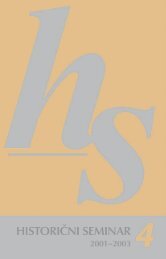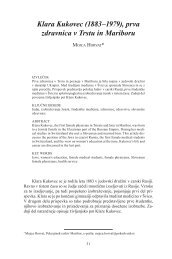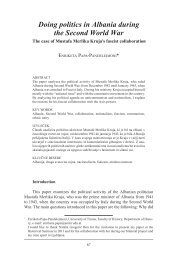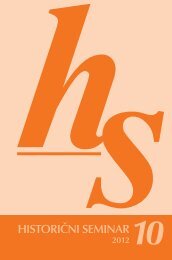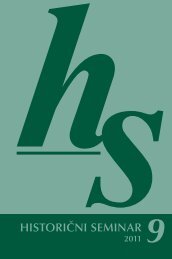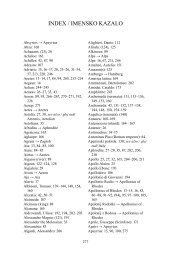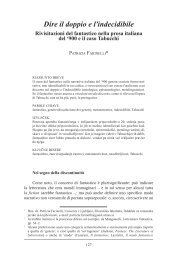The Invention of Modern Aesthetics: From Leibniz to Kant
The Invention of Modern Aesthetics: From Leibniz to Kant
The Invention of Modern Aesthetics: From Leibniz to Kant
Create successful ePaper yourself
Turn your PDF publications into a flip-book with our unique Google optimized e-Paper software.
<strong>The</strong> <strong>Invention</strong> <strong>of</strong> <strong>Modern</strong> <strong>Aesthetics</strong>: <strong>From</strong> <strong>Leibniz</strong> <strong>to</strong> <strong>Kant</strong><br />
In the following paragraph, § 19, Baumgarten says that »[i]ndividuals<br />
are determined in every respect«, and that therefore<br />
»particular representations are in the highest degree poetic«. 58 <strong>The</strong><br />
clarity that poetry can achieve, extensive clarity, differs from logical<br />
clarity; when poetry is said <strong>to</strong> be confused, we should keep in mind<br />
that »confused« is not synonymous with »obscure«, »nebulous«,<br />
»abstruse« and the like; it means rather that the »representations<br />
are fused <strong>to</strong>gether and [are] not sharply discriminated«. 59 Poetic<br />
clarity has <strong>to</strong> do with vivid details and poetic representations are<br />
fused <strong>to</strong>gether in<strong>to</strong> a satisfying whole, as Aschenbrenner and Holther<br />
explain, »[w]e should say <strong>to</strong>day that the ideal poetic representation is a<br />
highly condensed symbol, rich with ambiguity and as complex as the<br />
poet can contrive«. 60<br />
A poem, Baumgarten claims, is »a perfect sensate discourse«<br />
(§ 9), where »sensate discourse« means »discourse involving sensate<br />
representations« (§ 4), the latter being deined as »representations received<br />
through the lower part <strong>of</strong> the cognitive faculty« (§ 3). Several<br />
different intellectual activities concern themselves with poetry (and<br />
with the arts in general) in various ways: »a poem«, says Baumgarten,<br />
is »a perfect sensate discourse«, »poetics« is »the body <strong>of</strong> rules <strong>to</strong><br />
which a poem conforms and by »philosophical poetics« he means »the<br />
science <strong>of</strong> poetics« (§ 9). In the penultimate paragraph <strong>of</strong> his treatise<br />
Baumgarten then gives his deinition <strong>of</strong> aesthetics as »the science <strong>of</strong><br />
perception«, whose objects are things perceived and which »are <strong>to</strong> be<br />
known by the inferior faculty« (§ 116). <strong>Aesthetics</strong> is thus concerned<br />
with a form <strong>of</strong> knowledge, albeit <strong>of</strong> an inferior kind compared <strong>to</strong> rational<br />
(logical) knowledge, but this knowledge is a necessary precondition<br />
for the development <strong>of</strong> rational or logical knowledge as Baumgarten<br />
makes clear: logic has <strong>of</strong>ten been regarded as an aid for improving<br />
our reason, but »since we know that distinct knowledge is based on<br />
58<br />
Ibid., § 19, p. 43; »§ XIX. Individua sunt omnimode determinata, ergo repraesentationes<br />
singulares sunt admodum poeticae § 18.« (Meditationes, p. 10).<br />
59<br />
Aschenbrenner & Holther, »Introduction«, p. 21. <strong>The</strong> distinction between intensive<br />
and extensive clarity is also expounded in the Metaphysica § 531, where Baumgarten<br />
says that »an extensively clearer perception (image) is vivid. <strong>The</strong> vividness <strong>of</strong><br />
thought and presentation is brilliance […] the opposite <strong>of</strong> which is dryness« (»Extensive<br />
clarior perceptio est VIVIDA. Vividitas COGITATIONUM et ORATIONIS<br />
NITOR […] est cuius oppositum est SICCITAS«), Texte zur Grundlegung der Ästhetik,<br />
pp. 14–15, my transl.<br />
60<br />
Aschenbrenner & Holther, »Introduction«, p. 22. Cf. Nelson Goodman’s theory <strong>of</strong><br />
»the ive symp<strong>to</strong>ms <strong>of</strong> the aesthetic«: syntactic density, semantic density, relative<br />
repleteness, exempliication and multiple and complex reference, where the<br />
three irst symp<strong>to</strong>ms have a certain afinity with Baumgarten’s »confused poetic<br />
discourse« (Nelson Goodman, Ways <strong>of</strong> Worldmaking, Indianapolis: Hackett, 1978,<br />
pp. 67–79).<br />
147



